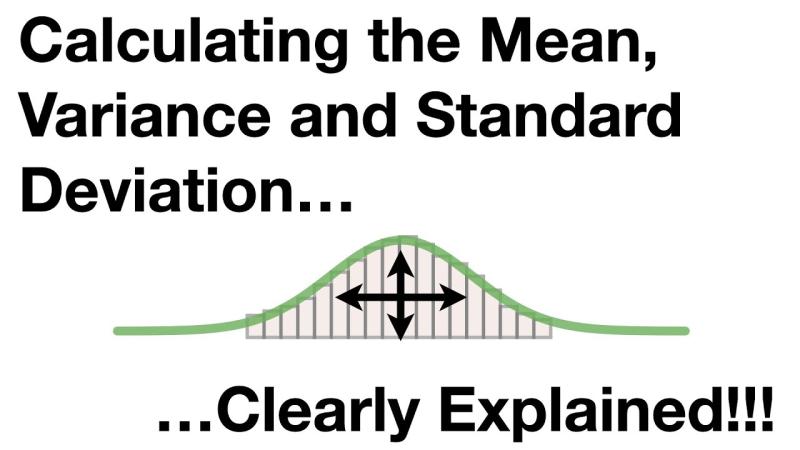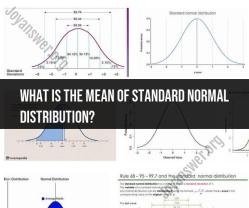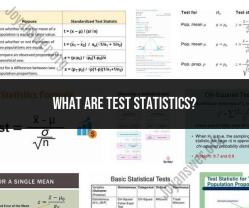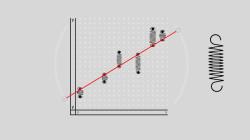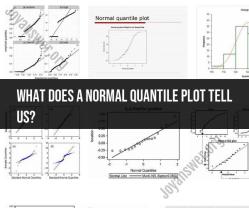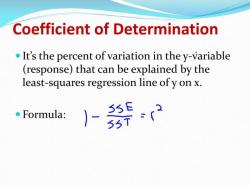What does the variance and standard deviation tell us?
Variance and standard deviation are statistical measures that provide information about the spread or dispersion of a set of data points. Both measures quantify the extent to which individual data points deviate from the mean (average) of the data set. Here's what variance and standard deviation tell us:
1. Variance:
- Definition: Variance is the average of the squared differences from the mean. It measures how far each data point in the set is from the mean and provides a sense of the overall variability of the data.
- Formula: For a population, the variance (σ²) is calculated as the sum of the squared differences between each data point (X) and the mean (μ), divided by the number of data points (N).
Variance and standard deviation are statistical measures that provide information about the spread or dispersion of a set of data points. Both measures quantify the extent to which individual data points deviate from the mean (average) of the data set. Here's what variance and standard deviation tell us:
1. Variance:
- Definition: Variance is the average of the squared differences from the mean. It measures how far each data point in the set is from the mean and provides a sense of the overall variability of the data.
- Formula: For a population, the variance (σ²) is calculated as the sum of the squared differences between each data point (X) and the mean (μ), divided by the number of data points (N).
- Interpretation: A higher variance indicates greater variability in the data, while a lower variance suggests that the data points are closer to the mean.
2. Standard Deviation:
- Definition: The standard deviation is the square root of the variance. It provides a measure of the average distance between each data point and the mean. In other words,
Variance and standard deviation are statistical measures that provide information about the spread or dispersion of a set of data points. Both measures quantify the extent to which individual data points deviate from the mean (average) of the data set. Here's what variance and standard deviation tell us:
1. Variance:
- Definition: Variance is the average of the squared differences from the mean. It measures how far each data point in the set is from the mean and provides a sense of the overall variability of the data.
- Formula: For a population, the variance (σ²) is calculated as the sum of the squared differences between each data point (X) and the mean (μ), divided by the number of data points (N).
- Interpretation: A higher variance indicates greater variability in the data, while a lower variance suggests that the data points are closer to the mean.
2. Standard Deviation:
- Definition: The standard deviation is the square root of the variance. It provides a measure of the average distance between each data point and the mean. In other words, it represents the typical amount of deviation from the mean.
- Formula: For a population, the standard deviation (σ) is the square root of the variance.
- Interpretation: A higher standard deviation indicates greater variability and spread of data points, while a lower standard deviation suggests that data points are closer to the mean.
Key Points and Interpretations:
- Spread of Data: Both variance and standard deviation provide information about how spread out or dispersed the data set is.
- Magnitude of Deviation: Larger standard deviation or variance values indicate greater deviation of data points from the mean.
- Consistency: Smaller standard deviation or variance values indicate more consistency or homogeneity in the data set.
- Relative Comparison: Standard deviation is especially useful for making relative comparisons between data sets with different units or scales.
Example:
- Consider two data sets:
- Data Set A: [10, 12, 11, 9, 10]
- Data Set B: [5, 20, 8, 15, 10]
- Both sets have the same mean (10), but Data Set B has a higher variance and standard deviation because its data points deviate more from the mean.
In summary, variance and standard deviation quantify the extent of variability in a data set. These measures are valuable for understanding the distribution of data points and assessing the consistency or dispersion of values around the mean. They are commonly used in statistical analysis, research, and various fields, including finance, science, and social sciences.
it represents the typical amount of deviation from the mean. - Formula: For a population, the standard deviation (σ) is the square root of the variance.
- Interpretation: A higher standard deviation indicates greater variability and spread of data points, while a lower standard deviation suggests that data points are closer to the mean.
Key Points and Interpretations:
- Spread of Data: Both variance and standard deviation provide information about how spread out or dispersed the data set is.
- Magnitude of Deviation: Larger standard deviation or variance values indicate greater deviation of data points from the mean.
- Consistency: Smaller standard deviation or variance values indicate more consistency or homogeneity in the data set.
- Relative Comparison: Standard deviation is especially useful for making relative comparisons between data sets with different units or scales.
Example:
- Consider two data sets:
- Data Set A: [10, 12, 11, 9, 10]
- Data Set B: [5, 20, 8, 15, 10]
- Both sets have the same mean (10), but Data Set B has a higher variance and standard deviation because its data points deviate more from the mean.
In summary, variance and standard deviation quantify the extent of variability in a data set. These measures are valuable for understanding the distribution of data points and assessing the consistency or dispersion of values around the mean. They are commonly used in statistical analysis, research, and various fields, including finance, science, and social sciences.
an>(Xi−μ)2 - Interpretation: A higher variance indicates greater variability in the data, while a lower variance suggests that the data points are closer to the mean.
2. Standard Deviation:
- Definition: The standard deviation is the square root of the variance. It provides a measure of the average distance between each data point and the mean. In other words, it represents the typical amount of deviation from the mean.
- Formula: For a population, the standard deviation (σ) is the square root of the variance.
- Interpretation: A higher standard deviation indicates greater variability and spread of data points, while a lower standard deviation suggests that data points are closer to the mean.
Key Points and Interpretations:
- Spread of Data: Both variance and standard deviation provide information about how spread out or dispersed the data set is.
- Magnitude of Deviation: Larger standard deviation or variance values indicate greater deviation of data points from the mean.
- Consistency: Smaller standard deviation or variance values indicate more consistency or homogeneity in the data set.
- Relative Comparison: Standard deviation is especially useful for making relative comparisons between data sets with different units or scales.
Example:
- Consider two data sets:
- Data Set A: [10, 12, 11, 9, 10]
- Data Set B: [5, 20, 8, 15, 10]
- Both sets have the same mean (10), but Data Set B has a higher variance and standard deviation because its data points deviate more from the mean.
In summary, variance and standard deviation quantify the extent of variability in a data set. These measures are valuable for understanding the distribution of data points and assessing the consistency or dispersion of values around the mean. They are commonly used in statistical analysis, research, and various fields, including finance, science, and social sciences.
Beyond the numbers: What variance and standard deviation reveal
Variance and standard deviation are statistical measures that quantify the spread of a data set. Variance is the average squared deviation of each data point from the mean, while standard deviation is the square root of variance.
These two measures can reveal a lot about a data set, including:
- The spread of the data: A higher variance or standard deviation indicates that the data is more spread out, while a lower variance or standard deviation indicates that the data is more tightly clustered around the mean.
- The presence of outliers: Outliers are data points that are significantly different from the rest of the data set. A high variance or standard deviation can indicate the presence of outliers.
- The nature of the distribution: Variance and standard deviation can be used to determine the nature of the distribution of the data, such as whether it is normal, skewed, or uniform.
Analyzing risk and variability: The role of variance and standard deviation
Variance and standard deviation are widely used in business and finance to analyze risk and variability. For example, businesses may use variance and standard deviation to:
- Assess the risk of a new product launch
- Monitor the variability of production costs
- Evaluate the performance of a portfolio of investments
By understanding variance and standard deviation, businesses can make better decisions about how to allocate resources, manage risk, and achieve their goals.
Practical implications: How businesses leverage variance and standard deviation
Here are some specific examples of how businesses leverage variance and standard deviation:
- Manufacturing: A manufacturing company might use variance and standard deviation to monitor the quality of its products. For example, the company might track the variation in the weight of its products to ensure that they meet customer specifications.
- Finance: A financial institution might use variance and standard deviation to assess the risk of a loan applicant. For example, the institution might look at the applicant's income and credit history to determine how variable their income is and how likely they are to default on the loan.
- Marketing: A marketing company might use variance and standard deviation to evaluate the effectiveness of its marketing campaigns. For example, the company might track the variation in website traffic and sales after launching a new campaign to see if it is having the desired effect.
Communicating insights: Conveying variance and standard deviation to stakeholders
When communicating variance and standard deviation to stakeholders, it is important to use clear and concise language. It is also important to explain what the numbers mean and how they can be used to make better decisions.
Here are some tips for communicating variance and standard deviation to stakeholders:
- Use plain language. Avoid using technical jargon and acronyms that your audience may not understand.
- Explain the context. Explain what the data represents and how it was collected.
- Interpret the results. Explain what the variance and standard deviation numbers mean and how they can be used to make better decisions.
- Use visuals. Visualizations such as charts and graphs can be helpful for communicating variance and standard deviation to stakeholders.
Varied perspectives: Different interpretations of variance and standard deviation
Variance and standard deviation can be interpreted in different ways, depending on the context. For example, a high variance in a data set could be seen as a good thing or a bad thing, depending on the situation.
In some cases, a high variance may indicate that the data is more diverse and representative of a larger population. For example, a high variance in the scores on a standardized test might indicate that the test is fair and unbiased.
In other cases, a high variance may indicate that the data is unreliable or that there are outliers present. For example, a high variance in the profits of a company might indicate that the company is experiencing financial instability or that there are fraudulent transactions occurring.
It is important to interpret variance and standard deviation carefully, taking into account the context of the data and the specific goals of the analysis.
